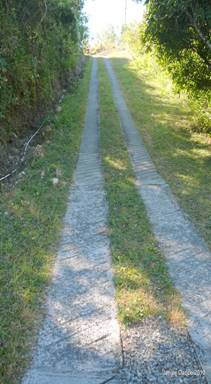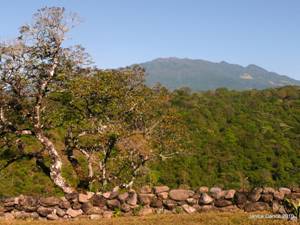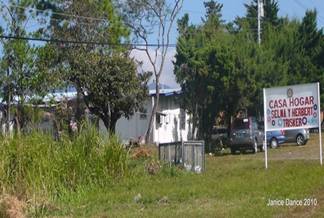Casa Hogar - (4)

|
I was quite nervous about my visit to the orphanage. Having never been to an orphanage before I didn’t know what to expect, would I be able to cope emotionally?? I didn’t know, but at 10am I was going to find out. I put on my backpack loaded with clothes, crayons and pencils and set off for the orphanage. My first challenge was to get up the hill to the road. I am so unfit and it is soooo steep, more like a ski jump than a drive, which with the addition of a heavy backpack, made it even harder for me. Puffing and panting I reached the top, at this rate, by the end of the week I will have buttocks like rocks ( I wish)!!!
I was to meet Pat and Bob outside the orphanage. As I stood outside I noticed the razor wire and wondered ‘is that to keep intruders out or keep the children in?’
There were other volunteers besides me, Stacy and Randy (who bore an uncanny resemblance to David Beckham!!) and Eloise. Pat gave us a prep talk, ‘don’t take your personal belongings and bags in, it’s not the children you have to worry about, it’s the staff’…..great start huh? So Stacy let us keep them in their car. Pat gave us a brief history of the Casa Hogar. Apparently the house was provided by a Bolivian gentleman who was born there. But when he came back and saw how the orphanage was being run, he was unhappy and the government took over its responsibility. It is the only orphanage in Panama that the government is responsible for and you would have thought they would have done a good job, I only wish it were so. Pat had to leave us, as she and the manager were going to David for a meeting to discuss the possibility of taking the orphanage over. The Bolivian gentleman, has sold the property to the David Rotary club for $1, to keep it out of the governments hands (not quite sure how that all works because Pat was in a terrible hurry). Apparently the Panamanians do not follow an adoption policy, they prefer the children to go back to the family. They not only don’t adopt to foreigners, but they won’t adopt to Panamanians either. Many of the children have no known family, like one little girl, whose mother gave birth in the hospital in David and then left, without the her. So they are condemned and I use the word specifically, to a life in the orphanage. I would have loved to take photos but they weren’t allowed. We were led into one room, that was full of toddlers. Many of them were covered in sores, which I thought were ‘Chitres’ bites (no-see-ums) that had been scratched. It was only later that I found out they had an outbreak of Chickenpox. I have never had chickenpox!!!!! Let’s hope it stays that way. It seems the only activity they children did was colouring and watching the huge LCD TV. So a child would grab your hand, tear a page out of the colouring book and colour it in while you sat and watched. Julian, a little 9 year old that had a very cynical look about him, was colouring in a picture of Sponge Bob, which he did very neatly. After he had completed each part he would show me. Then there was a lovely little boy called Juan, he was about 3 I think, who climbed up on my knee and started showing me pictures of cars and buses and animals. I started asking him how to say things in Spanish and he would tell me, then I started to sing ‘the wheels on the bus’ which is my grandson, Calum’s, favourite song. Well it is now Juan’s as he kept asking me to sing it again while he went round and round the wheels with his fingers. He was the only child who actually behaved like a child, giggling when I roared like a bear or oinked like a pig. Another little boy sitting opposite was taken out for ‘Pampers’ as he’d had a serious accident that his present ‘Pampers’ couldn’t contain. And so the morning passed. There was another volunteer there, some middle aged chap (older than me) who did a very odd thing. The children who were colouring, would use the book to rest on as it was easier to colour. Well he came over to one little girl who was colouring and virtually snatched the book from under her page without saying a word. He then went and put it in his carrier bag. Firstly, what kind of an example did that set, no please, no thank you, secondly why take it back, do they only get to play with his book when he is there?? I didn’t like him at all. I went into the babies room. There were 7 babies, the youngest, Jasmine, was only 2 months old. Then one of the toddlers (no more than 2 years old) hit another toddler who started to cry. Not one of the assistants even bothered to see if he was alright, one lady (dressed in a pristine white uniform and Stilletto heeled shoes) just shrugged and said they were ‘hermanos’, brothers. I picked him up. He was the little boy who had been taken out for ‘Pampers’. But either he had a very bad problem or an hour later he had still not been changed. There was no physical contact between the carers (and I use that term loosely as they seemed very little care at all) and the children. In the nursery the children were standing in their cots, being fed. The babies were just left lying there. It was very disturbing. I peeked through the window of what passes for the classroom. A young girl opened the door and we chatted. Their ‘teacher’ was on holiday so they have no school at the moment. When I asked how long she had been gone I was told 2 months!! Then I chatted with Tammy, a young American woman, who has been volunteering for 6 months. The girl she was sitting with was a very good artist. Tammy told me that on February 7th the girl, whose name Tammy can’t pronounce, would be 18 and then has to leave the orphanage. Another disturbing thing about the ‘system’ is that there is no support when the children leave. So this girl was out ‘on her own’. Now bear in mind that she has little schooling and has been institutionalised, how on earth is she going to cope in the outside world??? Now I hope I may be able to help in this case, it would be nice to think something good came out of my visit. I told Tammy about Ken, the owner of the place I am staying. He is a very nice Canadian who has helped other young people in the past. He trained one young man in the hospitality industry and taught him to speak English and now that young man lives in Canada and has a job. So I told Tammy I would ask Ken if he needs a housekeeper or cleaner or something. I was upset to see the conditions that the 65 children live in. Don’t get me wrong, it is not squalid, but it is more like a prison than anywhere a child should live. They are un-structured and un-disciplined. I have, through my work in urban regeneration, been involved in lots of day care centres and nurseries, where children are taught social skills and playing skills in a structured and disciplined manner. In fact I project managed the building of a ‘centre of excellence’ for childcare, how different it is to what passes for child care at Casa Hogar. Here they were just ‘watched’. The carers sat and chatted to each other, now I don’t know if this was because the volunteers were there or what, but zoo keepers show more emotion towards their charges than any of the girls I saw did for the children. A comparison that was confirmed when I went to the animal rescue centre later on. There were some lovely children there, perhaps I should call Madonna or Angelina, I’ll bet they could get things changed in Panama??? All in all it was a very disturbing experience. I felt totally ineffectual, useless. I wondered whether the volunteers that go every week actually make it any better for the children, or make it worse? Why? Because the children know that in 2 hours the volunteers will leave and they have to stay!! |

 Ken was right, at least I could see the Volano and
the Volacanito.
Ken was right, at least I could see the Volano and
the Volacanito. Another thing I found strange, was the lack of noise.
In primary schools, nurseries etc, you always hear the hubbub of children
playing, chatting, laughing and shouting, but here there was nothing. I assumed
that they must be in lessons or something??
Another thing I found strange, was the lack of noise.
In primary schools, nurseries etc, you always hear the hubbub of children
playing, chatting, laughing and shouting, but here there was nothing. I assumed
that they must be in lessons or something??